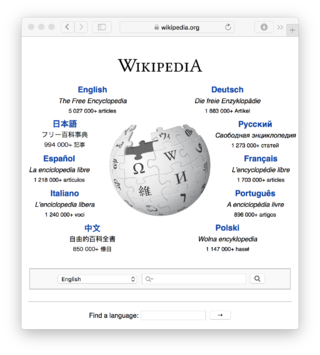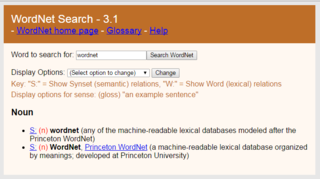Related Research Articles

The Semantic Web, sometimes known as Web 3.0, is an extension of the World Wide Web through standards set by the World Wide Web Consortium (W3C). The goal of the Semantic Web is to make Internet data machine-readable.

Wiki software is collaborative software that runs a wiki, which allows the users to create and collaboratively edit pages or entries via a web browser. A wiki system is usually a web application that runs on one or more web servers. The content, including previous revisions, is usually stored in either a file system or a database. Wikis are a type of web content management system, and the most commonly supported off-the-shelf software that web hosting facilities offer.

WordNet is a lexical database of semantic relations between words that links words into semantic relations including synonyms, hyponyms, and meronyms. The synonyms are grouped into synsets with short definitions and usage examples. It can thus be seen as a combination and extension of a dictionary and thesaurus. While it is accessible to human users via a web browser, its primary use is in automatic text analysis and artificial intelligence applications. It was first created in the English language and the English WordNet database and software tools have been released under a BSD style license and are freely available for download from that WordNet website. There are now WordNets in more than 200 languages.
In information science, an ontology encompasses a representation, formal naming, and definitions of the categories, properties, and relations between the concepts, data, or entities that pertain to one, many, or all domains of discourse. More simply, an ontology is a way of showing the properties of a subject area and how they are related, by defining a set of terms and relational expressions that represent the entities in that subject area. The field which studies ontologies so conceived is sometimes referred to as applied ontology.
Semantic similarity is a metric defined over a set of documents or terms, where the idea of distance between items is based on the likeness of their meaning or semantic content as opposed to lexicographical similarity. These are mathematical tools used to estimate the strength of the semantic relationship between units of language, concepts or instances, through a numerical description obtained according to the comparison of information supporting their meaning or describing their nature. The term semantic similarity is often confused with semantic relatedness. Semantic relatedness includes any relation between two terms, while semantic similarity only includes "is a" relations. For example, "car" is similar to "bus", but is also related to "road" and "driving".
A semantic wiki is a wiki that has an underlying model of the knowledge described in its pages. Regular, or syntactic, wikis have structured text and untyped hyperlinks. Semantic wikis, on the other hand, provide the ability to capture or identify information about the data within pages, and the relationships between pages, in ways that can be queried or exported like a database through semantic queries.
In computer science, the semantic desktop is a collective term for ideas related to changing a computer's user interface and data handling capabilities so that data are more easily shared between different applications or tasks and so that data that once could not be automatically processed by a computer could be. It also encompasses some ideas about being able to share information automatically between different people. This concept is very much related to the Semantic Web, but is distinct insofar as its main concern is the personal use of information.
The concept of the Social Semantic Web subsumes developments in which social interactions on the Web lead to the creation of explicit and semantically rich knowledge representations. The Social Semantic Web can be seen as a Web of collective knowledge systems, which are able to provide useful information based on human contributions and which get better as more people participate. The Social Semantic Web combines technologies, strategies and methodologies from the Semantic Web, social software and the Web 2.0.
Semantic analytics, also termed semantic relatedness, is the use of ontologies to analyze content in web resources. This field of research combines text analytics and Semantic Web technologies like RDF. Semantic analytics measures the relatedness of different ontological concepts.
NEPOMUK is an open-source software specification that is concerned with the development of a social semantic desktop that enriches and interconnects data from different desktop applications using semantic metadata stored as RDF. Between 2006 and 2008 it was funded by a European Union research project of the same name that grouped together industrial and academic actors to develop various Semantic Desktop technologies.
Data preprocessing can refer to manipulation, filtration or augmentation of data before it is analyzed, and is often an important step in the data mining process. Data collection methods are often loosely controlled, resulting in out-of-range values, impossible data combinations, and missing values, amongst other issues.
LanguageWare is a natural language processing (NLP) technology developed by IBM, which allows applications to process natural language text. It comprises a set of Java libraries which provide a range of NLP functions: language identification, text segmentation/tokenization, normalization, entity and relationship extraction, and semantic analysis and disambiguation. The analysis engine uses Finite State Machine approach at multiple levels, which aids its performance characteristics, while maintaining a reasonably small footprint.
Amit Sheth is a computer scientist at University of South Carolina in Columbia, South Carolina. He is the founding Director of the Artificial Intelligence Institute, and a Professor of Computer Science and Engineering. From 2007 to June 2019, he was the Lexis Nexis Ohio Eminent Scholar, director of the Ohio Center of Excellence in Knowledge-enabled Computing, and a Professor of Computer Science at Wright State University. Sheth's work has been cited by over 48,800 publications. He has an h-index of 106, which puts him among the top 100 computer scientists with the highest h-index. Prior to founding the Kno.e.sis Center, he served as the director of the Large Scale Distributed Information Systems Lab at the University of Georgia in Athens, Georgia.
A concept search is an automated information retrieval method that is used to search electronically stored unstructured text for information that is conceptually similar to the information provided in a search query. In other words, the ideas expressed in the information retrieved in response to a concept search query are relevant to the ideas contained in the text of the query.
Taxonomy is the practice and science of categorization or classification.
The following outline is provided as an overview of and topical guide to natural-language processing:
Automatic taxonomy construction (ATC) is the use of software programs to generate taxonomical classifications from a body of texts called a corpus. ATC is a branch of natural language processing, which in turn is a branch of artificial intelligence.
The Open Semantic Framework (OSF) is an integrated software stack using semantic technologies for knowledge management. It has a layered architecture that combines existing open source software with additional open source components developed specifically to provide a complete Web application framework. OSF is made available under the Apache 2 license.
Cassandre is a free open source software for computer assisted qualitative data analysis and interpretation in humanities and social sciences. Although it refers, like other CAQDAS-software, to Grounded Theory Method, it also allows to conduct discourse analysis or quantitative content analysis. The software is designed as a server to support collaborative work. Formerly focused on semi-automatic coding, it now provides diaries assisting qualitative analysis.

In knowledge representation and reasoning, a knowledge graph is a knowledge base that uses a graph-structured data model or topology to represent and operate on data. Knowledge graphs are often used to store interlinked descriptions of entities – objects, events, situations or abstract concepts – while also encoding the semantics or relationships underlying these entities.
References
- ↑ According to http://www.semantic-knowledge.com/download.htm Archived 2019-08-06 at the Wayback Machine . Retrieved 15 August 2015.